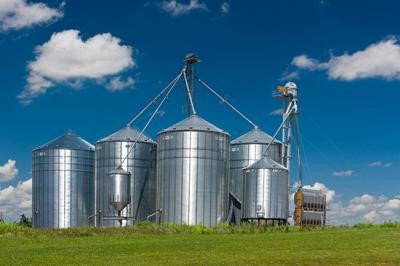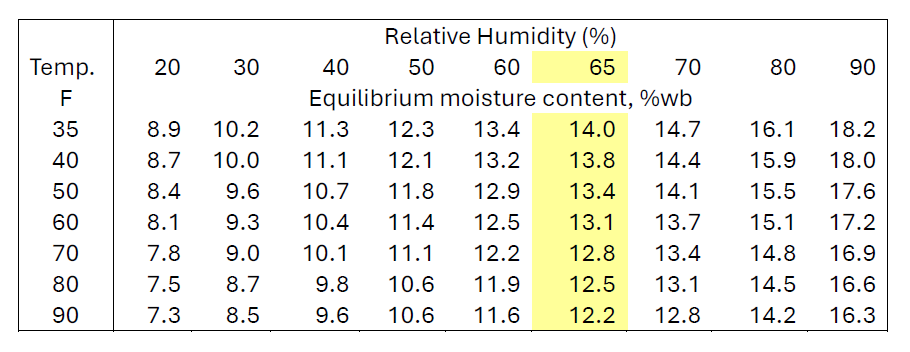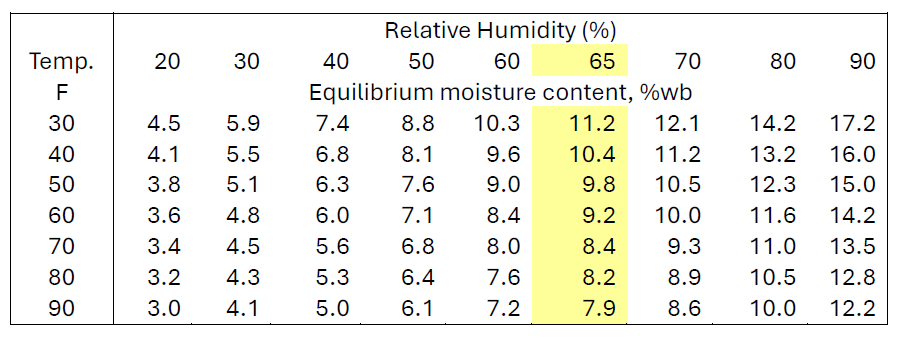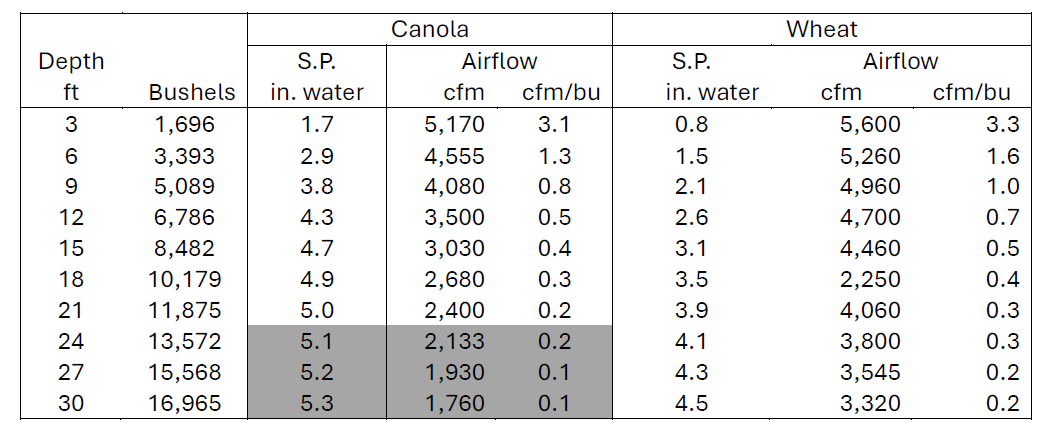Postharvest Management of Canola and Wheat
Postharvest Management of Canola and Wheat

Canola and wheat are mostly harvested across Kentucky, so now is a good time to review some of the physical properties of these crops in order to maintain their quality during storage. An important consideration is how these grains interact with air to control biological activity that can potentially cause spoilage and a loss in value. This article focuses on the factors that determine the storability of these crops, namely grain moisture, temperature, and initial condition after harvest (amount of trash and broken grain); and the specific airflow requirements for drying and conditioning these small seeds. Keeping grain in good condition during storage prevents clumps from forming in a bin and the safety risks associated with entering one altogether.
Equilibrium moisture represents the point when there is no exchange of water vapor between seed and the surrounding air and establishes the grain-specific limits of drying and storage. This occurs after sufficient exposure time in the field or in bin dryers with little or no heat added. Tables 1 and 2 show the equilibrium properties for wheat and canola, respectively, for specific temperature and relative humidity conditions. Keep in mind that molds begin to grow when the relative humidity is above 65% (highlighted column in both tables) and that the average monthly temperature in Kentucky during July and August is about 80 degrees. Thus, the recommended storage moisture for soft red winter wheat is 12.5%. For canola at 40% oil content, the seed should be 8.2% moisture for safe storage. However, canola seeds with 50% oil should be stored at a lower moisture of 6.5% to preserve seed quality.
Table 1. Equilibrium moisture content of soft red winter wheat (%wb) at different temperature and relative humidity levels. Source: ASAE Data D245.6.

Table 2. Equilibrium moisture content of canola (%wb) with 40% oil content at different temperature and relative humidity levels. Source: ASAE Data D245.6.

All stored grain should be cooled to 60 degrees as soon as possible in late summer or early fall to control insect activity as well. Tables 1 and 2 also show that at this temperature, soft red winter wheat at 12.5% creates a relative humidity in the bin of about 60%, which adds further protection to hold mold growth in check. Similarly, canola seeds with an oil content of 40% and 8.2% moisture will create an RH of about 62%.
Drying time will depend on the weather conditions and airflow rate through grain, which in turn depends on the depth. The minimum airflow rate for natural air and low-temperature drying is 1 cubic feet per minute/bushel, which can require considerable fan power and severely limit the depth of small grains in most farm bins. The airflow rate in an existing bin can quickly be estimated by a decision tool from the University of Minnesota. By entering the bin diameter, wall height, desired airflow rate, grain and floor type, the number of bushels, static pressure and airflow rate per bushel are calculated in 2-4 feet intervals, depending on the eave height.
An example for canola and wheat in a 30 ft diameter bin with a 30 ft eave height and a typical 3 hp centrifugal fan that can deliver 2500 cfm at 5.0 inches of static pressure is shown in Table 3. Keep in mind that the program extrapolates values slightly beyond the fan data and the calculated resistance to airflow (static pressure, shown as inches of water) generated at a specific depth can exceed the capability of the fan. In this example, the selected fan will perform well for wheat but exceeds its limit for canola above 21 feet (as shown in the highlighted values). Note that other recommended airflow rates can also be evaluated by this program including 0.5 cfm/bu for cooling hot grain from a dryer and 0.1-0.2 cfm/bu for aeration. In this example, the minimum airflow rate for drying limits the depth to about 8 feet for canola and 9 feet for wheat. Also, when cooling hot grain from a dryer, the depth for canola and wheat should be limited to about 12 feet and 15 feet, respectively. Lastly, the rule of thumb for estimating the number of hours for aerating clean grain is easily calculated by dividing 15 by the airflow rate. So, 75 hours of total fan operation are needed when the bin is full (0.2 cfm/bu), whereas only 15 hours are needed at 1 cfm/bu.
More information on handling, drying and storing canola, wheat and other small grains is available in the references provided as well as your county extension office or by contacting the author.
Table 3. Airflow rates with a 3 hp centrifugal fan for canola and wheat in a 30-ft diameter bin filled to a depth of up to 30 feet. Source: Fan selection software from the University of Minnesota Department of Bioproducts and Bioengineering https://bbefans.cfans.umn.edu/

References:
ASAE Standard D245.6. 2017. Moisture Relationships of Plant-based Agricultural Products. ASABE St. Joseph, MI. Canola Council of Canada. 2024. Canola Encyclopedia: Harvest Management. https://www.canolacouncil.org/canola-encyclopedia/harvest-management
Canola Council of Canada. 2024. Canola Encyclopedia: Storage. https://www.canolacouncil.org/canola-encyclopedia/storage
Jones, C. & J. Solie. 2007. Storing Oklahoma Winter Canola. Oklahoma Cooperative Extension Service Pub. BAE-1110. http://canola.okstate.edu/ocesfactsheets/BAE1110Storing%20Oklahoma%20Winter%20Canola.pdf
Maier, D., S. McNeill & K. Hellevang. 2018. Storage In: Grain Drying, Handling and Storing. Midwest Plan Service Handbook MWPS-13. https://www.extension.iastate.edu/news/search/content/MWPS-13
McNeill, S., D. Overhults & M. Montross. 2009. Harvesting, Drying and Storing Wheat In: A Comprehensive Guide to Wheat Management in Kentucky. University of Kentucky Cooperative Extension Service. ID-125. https://publications.ca.uky.edu/sites/publications.ca.uky.edu/files/ID125.pdf
McNeill, S. & D. Overhults. 1992. Harvesting, Drying and Storing Canola In: Canola Production and Management. University of Kentucky Cooperative Extension Service. ID-114. (Archived).
Citation: McNeill, S., Postharvest Management of Canola and Wheat. Kentucky Field Crops News, Vol 1, Issue 7. University of Kentucky, July 11, 2025.
